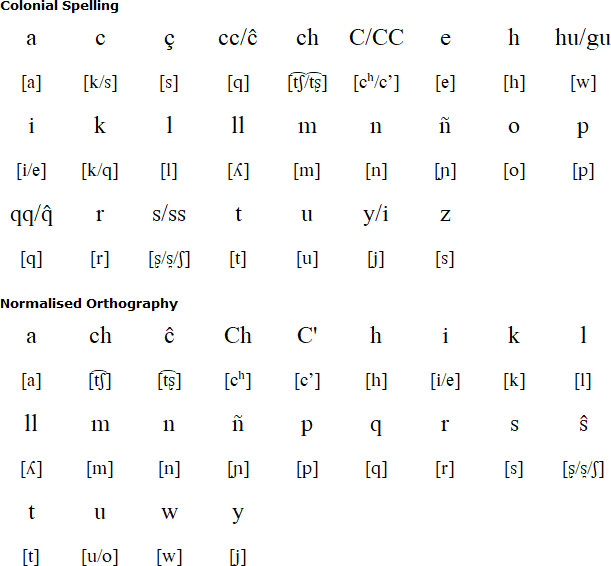The Quechuan languages are spoken in mainly in Peru, and also in Bolivia, Ecuador, Colombia and Argentina. They belong to the Quechuan language family, and have a total of about 7.7. million speakers. In Ecuador varities of Quechua are known as Quichua. The Quechuan languages are thought to have descended from a common ancestor, known as Proto-Quechua. The modern Quechuan languages are not mutually intelligible, and each variety has a number of dialects.
Varities of Quechua include:
Quechua was the language of the Inca Empire, and continued to be used as a lingua franca after the Spanish conquest in the 16th century. It was officially recognised by the Spanish, who learnt it to communicate with the Inca people, and also to spread Christianity among them. Quechua continued to be used in this way until the late 18th century, after which colonial officials ceased to use it in administration and for religious purposes, and banned its used in public in Peru.
There was a revival of Quechuan languages in the 19th century after Latin American nations gained independence, however the prestige of the language has fallen since then. Today Quechuan languages are the most widely spoken indigenous languages in South America.
Quechuan languages are officially recognised in Peru, Ecuador, Bolivia. Bilingual education in Quechua and Spanish is available in these countries. There are some broadcasts in Quechua on radio and television stations.
The Inca used a system of knotted strings known as quipu to send messages around their empire. The number and shape of the knots and the colours of the strings helped to remind messengers of the contents of the messages. Recent research suggests that the quipu might have been used not just as mnemonic devices but also to record the Quechua language phonetically.
Quechua first appeared in print in 1560 in the form of a dictionary by Domingo de Santo Tomás. Other early texts include collections of hymns by Cristóbal de Molina and a Quechua cathechism by Juardo Palomino.
Classical Quechua is the variety of Quechua that was used as the administrative language and lingua franca in the Inca Empire (1438-1533). It was also known as Inca lingua franca, and is not well-documented as the Incas did not write things down.
Classical Quechua also refers to the variety of Quechua used in religious and administrative written materials in the Andean territories of the Spanish Empire until the early 17th century. It is also known as Standard Colonial Quechua or lengua general ("common language").

Download an alphabet chart for Classical Quechua
Runa yndio ñiscap machonkuna ñaupa pacha quillcacta yachanman carca chayca hinantin causascancunapas manam canancamapas chincaycuc hinacho canman. Himanam viracochappas sinchi cascanpas canancama ricurin, hinatacmi canman.
Runa Indio ñisqap machunkuna ñawpa pacha qillqakta yacanman karqan chayqa hinantin kawsasqankunapas manam kanankamapas chinkaykuq hinachu kanman. Imanam wiraquchappas sinchi kasqanpas kanankama rikurin, hinataqmi kanman.
If the ancestors of the people called Indians had known writing in ancient times, then all the things they have lived certainly would not have kept disappearing like this until now, either. In the way the valorous acts of the Spaniards (Huiracochas) are still seen, too, so it would have been (with theirs as well).
Information about Quechua
http://en.wikipedia.org/wiki/Quechua_languages
https://es.wikipedia.org/wiki/Lenguas_quechuas
https://en.wikipedia.org/wiki/Classical_Quechua
Ambo-Pasco Quechua, Ancash Quechua, Ayacucho Quechua, Cajamarca Quechua, Classical Quechua, Cuzco Quechua, Huallaga Quechua, Huaylla Wanca Quechua, Kichwa, Santiagueño Quechua, South Bolivian Quechua
Languages written with the Latin alphabet
Page last modified: 07.11.22
[top]
You can support this site by Buying Me A Coffee, and if you like what you see on this page, you can use the buttons below to share it with people you know.

If you like this site and find it useful, you can support it by making a donation via PayPal or Patreon, or by contributing in other ways. Omniglot is how I make my living.
Note: all links on this site to Amazon.com, Amazon.co.uk
and Amazon.fr
are affiliate links. This means I earn a commission if you click on any of them and buy something. So by clicking on these links you can help to support this site.
[top]